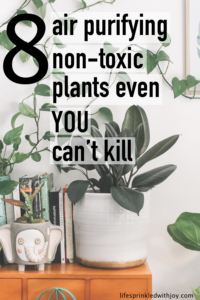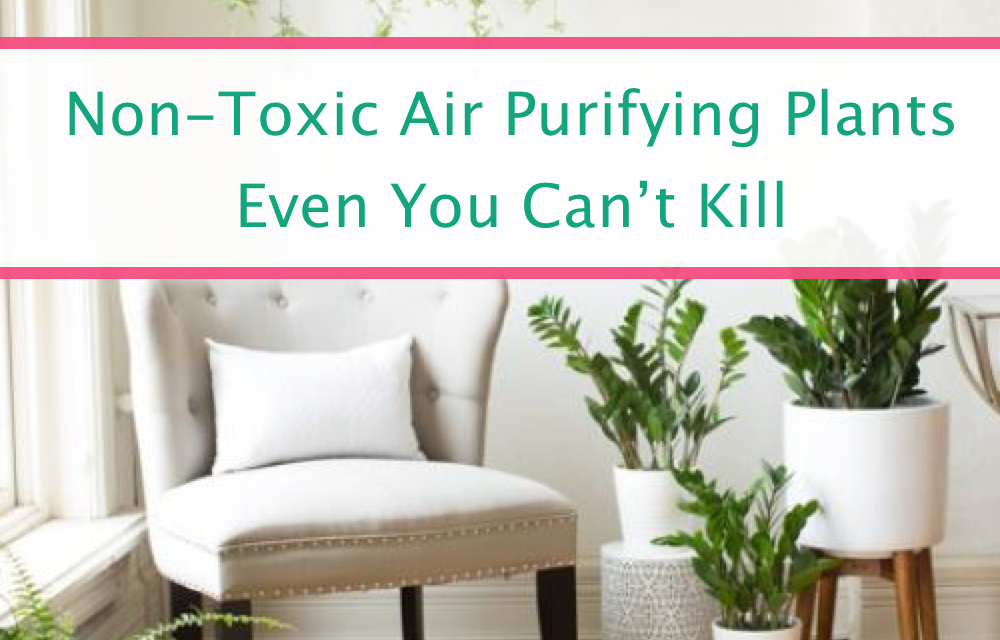While keeping your house clean isn’t easy, there are some definite shortcuts that help make it more manageable. But what about keeping your home clean and free from all the harmful elements you can’t see?
I’m talking about harmful chemicals like formaldehyde, xylene, toluene, ammonia, etc.
This stuff is gross and can cause some serious health issues for you and your family. Burning eyes, nausea, coughing—and some of these chemicals are even known human carcinogens.
And the problem isn’t that you knowingly let these chemicals into your house, it’s that they come in in the most unsuspecting forms. Like with fabrics, paper products, and disinfectants.
So what can you do? Well, there’s good news. NASA (that’s right, NASA!) has identified tons of air purifying plants that can help reduce the negative effects of these toxic chemicals in your home!
Now well there are plenty of household plants to choose from that can help purify your home’s air, if you have pets or kids you may want to stick with the non-toxic ones.
And, if you’re like me, you may also want to choose the non-toxic air purifying plants that are low maintenance.
You know, the ones that are pretty hard to kill—that don’t need a ton of sunlight or can go a few days without water because, let’s face it, you’re busy and all the work it takes to get your kids out the door tends to mean you’ll usually forget turning off the T.V. or that one light, or well, watering the plants.
So here’s a list of the best low maintenance (almost fool-proof!) non-toxic air purifying plants to help keep your family safe and free of harmful chemicals!
Spider Plant
A spider plant is a great houseplant to start with—not only will it help cleanse your home by taking in formaldehyde, xylene, toluene, and ammonia—it is great in a hanging basket!
Spider plants are non-toxic to kids, dogs, and cats (another your kitty will probably like to chew on the ends), and are perfect for absorbing chemicals released in freshly painted rooms or for apartments in areas exposed to big city chemicals.
Water spider plants every 10 to 14 days (allow for the soil to get dry between waterings), and provide access to bright sunlight—although these plants will adapt nicely to low light.
Christmas Cactus
Don’t be confused by the name here—although it’s a cactus the Christmas Cactus doesn’t have any of those painful stickers to worry about.
And just because the name implies all things holiday (it’s also called a Thanksgiving Cactus) that’s only because it blooms November through January—which provides the perfect burst of color for your home during those dreary winter months.
A Christmas Cactus will adapt to lower light, but it will bloom more frequently if it receives more light. Water consistently but do not let the plant sit in water—allow for proper drainage.
Jade Plant
The Jade Plant, like the Christmas Cactus, is another great non-toxic air purifying succulent for your home, and it makes a great year-around plant.
Water your jade plant when the top soil is dry to the touch, and make sure they get plenty of sun.
Boston Fern
Boston Ferns absorb formaldehyde, xylene, and toluene, and they also take in harmful chemicals released in gasoline. Hang a boston fern in your mudroom or where your garage attaches to your house, or put one on a pedestal in a well-lit bathroom (because these guys love humidity!).
Areca Palm
Areca palms are great if you have cats or dogs, and also good if anyone in your home are asthmatic. Now these can get pretty big, but they’re perfect for that sunny corner that you just don’t know what to do with.
Water your areca palm often, but allow the topsoil to dry between waterings. These plants need indirect light and tolerate pruning fairly well.
Money Tree Plant
The name of this plant is so cool—of course it’d be even cooler if money plants actually grew money.
Still, money plants are great for those with asthma and they’ll help remove benzene, formaldehyde, toluene and xylene from the air inside your home.
Money plants need indirect sunlight (although low light is fine) and relative humidity (try using a pebble tray for this). Water the plant when the top few inches get dry and make sure to allow for drainage.
Moth Orchids
Moth orchids are so pretty and are perfect for placing in freshly painted rooms to help absorb all the toxins.
If you live in an apartment in a larger city then this is the plant for you—they’re easy to maintain, pretty to look at, and help rid your home from harmful chemicals.
Place your moth orchid on a bright windowsill and water it every 7 to 10 days.
Adding greenery or flowering plants are great ways to perk up any room, like your kitchen, and give it a brighter vibe!
Purple Waffle Plant
Aside from the money plant, your kids will probably love the name of this plant the most.
The Purple Waffle Plant takes in formaldehyde and is great for homes that are located near factories or bigger city areas. These plants need indirect sunlight, humidity (try making a pebble tray to help provide this for your plants) and evenly moist soil.
Looking for more easy home projects? Check out How to Declutter Your WHOLE House In Just ONE Afternoon







